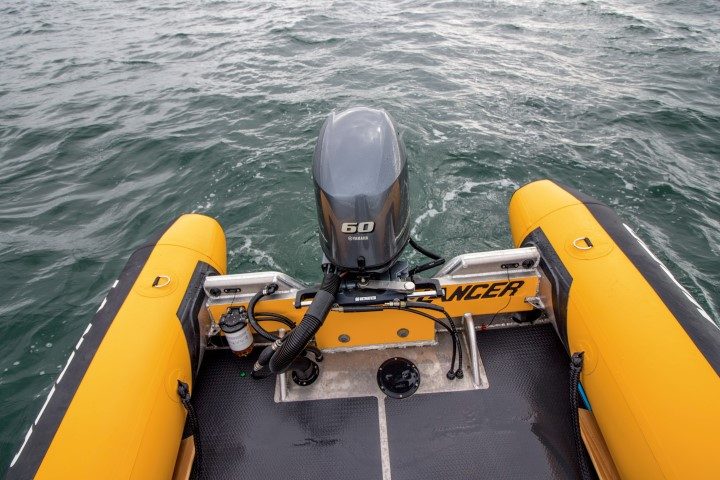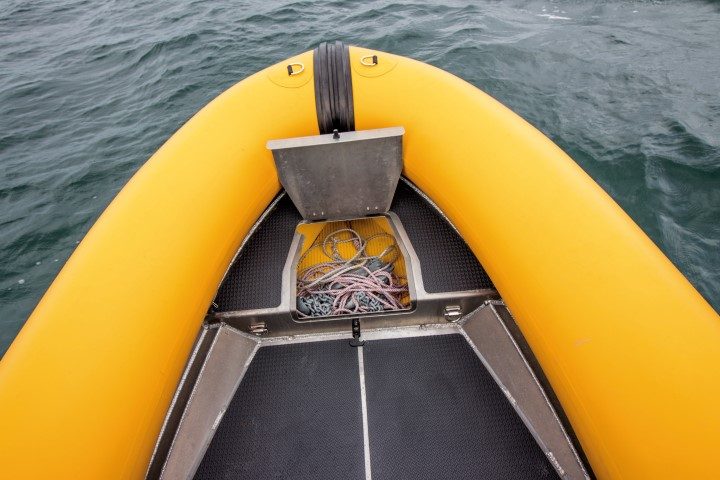‘Behemoth’ is a word which springs to mind or, perhaps more nautically, ‘leviathan’.

When Yachting New Zealand began looking for the ‘ultimate support boat’, it turned to Lancer Industries. The collaboration delivered a pair of hotties.
As New Zealand’s oldest manufacturer of ‘rubber ducks’ – and with more than 40 years of experience building Hypalon inflatable boats – Lancer had the experience and expertise to design and build to YNZ’s exacting requirements.

The project was in incubation for around 18 months, with initial discussions, concepts and design requirements started over two years ago. The boats would be in constant use, and needed to be capable of beach launching.
This implied they needed to be tough enough to handle surf conditions and able to be run up on a shingle beach or left on a concrete boat ramp while the trailer is fetched. A reinforced aluminium hull was the only way to go, providing toughness and rigidity while keeping the boat light enough for single-handed launching.
According to Ian Neely, Acting High Performance Manager at YNZ and a key member of the project team, coaching staff can be out on the boats up to six days a week. With current workplace health and safety regulations YNZ has a responsibility to ensure comfort and prevent injuries for the regular users.
So a hull that was comfortable at speed through the Hauraki Gulf chop was crucial, ideally “a five-metre hull that rides like an eight-metre.” This is achieved by the 28o deep vee amidships, a plumb bow with a knife-like 76o entry angle, and Lancer’s patented ‘3T’ tube design which integrates the tube’s cushioning effect into the ride characteristics.

Those tubes also help keep the interior dry, again a major consideration in Auckland’s choppy conditions. Sailing seldom stops for wind or rain, and the hull and tube profile deflect spray down and away from the occupants. Two sets of negative chines further assist in deflecting water, while giving directional control during cornering.
Another challenge was set by the need for ‘Clean Decks’, since course marks and other paraphernalia are often carried on board. On the other hand, everything below deck had to have good access, while the ability to run all day meant that removable tote tanks was the only sensible option.
This led to a clever straddle-seat that opens sideways to reveal a locker capable of storing two Yamaha 24-litre fuel tanks. This keeps the weight low and well-balanced while providing easy access to all lines and cables hidden beneath the decks.

Once the requirements had been established and the design finalised, it was the Yachting Youth World Championships held in Auckland at the end of 2016 that proved the impetus for the project to get going. A generous sponsorship from Pak ’n Save enabled the first two RK5000s to be built, with Lancer’s legacy yellow-coloured Hypalon tubes fitting the advertising brief exactly.
The final piece of the project was propulsion, and here YNZ was clear it wanted standard running gear. The boats get thrashed, and the engines are likely to be replaced several times during the lifetime of the hulls. Using off-the-shelf engines and props simplifies servicing, repairs and eventual replacement, and keeps everything cost-effective.
YNZ chose the Yamaha FT60 four-stroke, a rock-solid engine that’s quiet-running, economical and yet has plenty of grunt. The long-shaft model combined with the high-thrust gearbox option ensures that no matter how tightly the boat is turned the engine will not cavitate, another important safety consideration.

We took the boats into the Hauraki Gulf in typical conditions – about 15 knots of wind and a short and nasty chop. Definitely all-weather-jacket conditions, but pretty standard for sailors. Lancer borrowed both yellow RK5000s back from YNZ (YNZ’s other coaching boats are a more discreet grey) and we launched from the concrete ramp in Takapuna on Auckland’s North Shore.
Very quickly we discovered what these boats were about. One of the common actions of a coach boat is to turn suddenly and sharply, and it needs to do this without throwing the occupants out the boat. The boat excels at this, and handling is fantastic.
Even at 15 knots they can be turned 180o in just over twice their hull length, with the hull canting over to ensure the occupants remain comfortable. We did tight figure-eights at speed, not a typical manoeuvre, but one the vessel’s relished.

Setting and retrieving buoys is easy even when single-handed, thanks to the close-quarters manoeuvrability of the boat. The centre console and motorcycle-type seat layout make it easy to move around the deck, with nothing in the way to trip up the coach who will have his eyes out on the water rather than looking at his feet. Once the job’s done the Yamaha FT60 gets the boat up and going again very quickly indeed.
Scooting along the chop at maximum speed of around 30 knots was no problem, with that fine entry cutting through and smoothing out the ride. Top speed used to be almost irrelevant when coaching sailing, but with modern foiling boats that’s all changed. Fortunately, the Lancer RK5000 has no problem keeping up with all of YNZ’s racing classes.
The pontoons form a very effective fender all around, and rafting alongside another boat is easy and safe. To prevent snags the rope grab handles that are commonly installed on the outside of RIBs has been left off but a sturdy rope on the inside provides grab points for any occupants sitting on the pontoons.

The boats have now been in almost constant use for around nine months, and Neely says YNZ “is really happy with how the design performs and the final outcome.” Lancer has further extended the range, with a 4m and a 6.5m model now also available. Demand for the RK5000 has been good, including a pair just delivered to the Tuvalu Ministry of Natural Resources.
This may be a purpose-built workboat designed for coaching, but there is a lot to like about this even as a recreational vessel. The comfortable and dry-running but tough hull, fantastic handling and quiet, economical engine are a great combination. Other accessories are available, including bimini top, underfloor fuel tanks, lighting and electronics packages.
‘Behemoth’ is a word which springs to mind or, perhaps more nautically, ‘leviathan’.
White Pointer has earned the respect of discerning customers in New Zealand and Australia, attracting a loyal and ever growing following for its high-quality, rugged and totally dependable aluminium trailer boats.
The hardtop SP635 shares the same underpinnings as the popular SF 635 which was a completely new model back in 2020.
The pride and joy of a multi-generational family, Bliss resides on a pier that’s home to a couple of other Elite motor launches – Sandspit Marina is a hot-spot for the Bill Upfold-designed vessels, with several calling this small marina home.